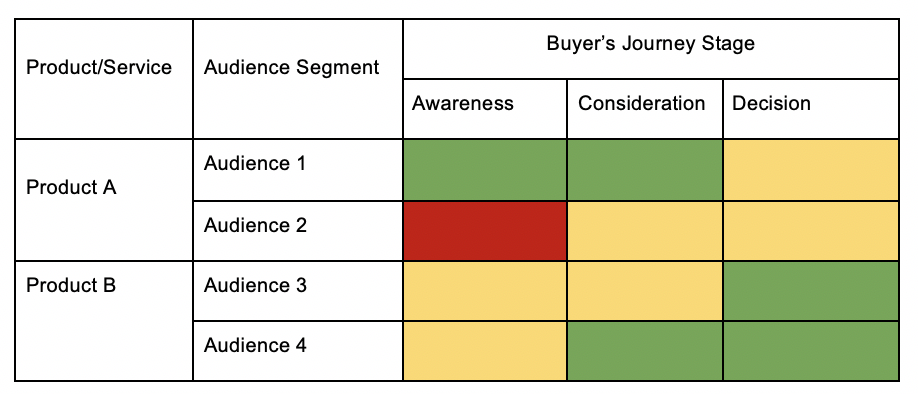For science marketing and communications professionals, time is at a premium. And admittedly, a content audit takes time and doesn’t directly bring in leads. So how and why should you squeeze a content audit into your already packed schedule?
Content audits serve as the foundation for a smarter and more targeted content and sales strategy. Done well, it will elevate your programs to a new level of efficiency by calling your attention to the totality of your resources, and importantly, where and how they need to be applied.
Below is a content audit guide to the key steps and strategy for undertaking this task, with some additional tips around maximizing your audit approach – and results.
First, What Is a Content Audit?
Many companies set goals for producing new content each quarter or year. There can be a variety of content objectives and formats, from supporting product launches with sales collateral and landing pages to educating potential customers with awareness-phase blog posts.
With most marketing teams fervently creating new resources, very few companies take the time to do the reverse: To prune back the content that no longer serves the customer and the brand.
This is where a content audit can be invaluable. By creating an inventory of all your existing content, you can systematically evaluate:
- What content needs to be retired: Does it match the professionalism of your products and services or is it detracting from the brand?
- What content needs to be refreshed: Is it in line with your current guidelines and messaging? Are the details still current or has that employee/author moved on?
- What content can be repurposed: Can a graphic from a presentation deck add value to a product page? Can an online infographic be printed as tradeshow collateral?
- What content gaps exist: Do you have content in place to help each audience segment evaluate your different products or services?
It’s important to understand the goals and strategy behind a content audit because it demands you shift time and energy away from producing new assets.
Timing Your Audit and Content Strategy
Certain situations create a prime opportunity for a content audit:
- You have an incoming team member:
Make the most of their initial ‘outside’ perspective by getting them to take an honest look at your existing content. This helps deliver objective results, while also onboarding your newest employee with your current content landscape – warts and all. - You’re planning a new content campaign:
Before launching into a new content strategy or campaign, ask yourself how much you really know about your existing materials. Is it clear what audiences you need to target and what existing assets you could use? If not, stop and audit. - Your company recently evolved:
So many big science companies are the product of ongoing mergers and acquisitions. This necessitates a fresh look at the content and an analysis of how the two brands and resources can blend. Likewise, a change to your messaging or branding may require a review of existing assets and a strategy for how to update or remove them. To see how a large company tackled a re-brand, read our Q&A with Ashland’s Carolmarie Brown.
It’s worth noting that you can also do a content audit division-by-division if you’re working with an industry giant or have limited resources. Ultimately, there needs to be a consistent message and tone across the company, but you don’t have to take it all on at once – especially if you’re working with different audiences.
What to Include in a Content Audit
Content audits can be a huge undertaking – particularly if you work at a behemoth science company with thousands of products, downloadables, and webpages. Conversely, they can also be small and specific. Maybe your company is still in the R&D phase. Startups are fast-moving and pivot often, so regular smaller audits can help align all of your content and messaging.
Whatever the case, you’ll have to make some decisions around what to include and what to leave out. Here are some examples of the depth and criteria that you might consider.
Content Audit Lite
If you are low on time and energy, just focus on the website content and gated materials, or other downloadables. Look at the content with fresh eyes and mark if you consider it high-quality, unique, and helpful to the user. If you’ve got personas built out, map out how each piece of content helps drive your buyer’s journey.
Size: Medium
With some personnel to help or a bit more time to dedicate, you and your team can expand your scope to sales collateral and also audit the tone, voice, and messaging of your content. Is it true to the current and future direction of your brand? In addition, you can assess the user’s experience (UX) when they land on the site. How do potential customers navigate to and find your content? Take a close look at your navigation menu and think through how the user can backtrack or see other related products. If the user experience is sub-par, you may be losing a lot of business.
To keep it achievable, focus on some key areas that can help increase conversion rates and increase ROI, like evaluating your calls-to-action. Is there some diversity in the copy or does every page ask a potential customer to “Get a Quote?” Are they positioned in a place that makes sense for a user? A revamp of your CTAs can be a quick and easy win in terms of getting users to sign up for your newsletter or make a purchase.
The Platinum Medallion Status Audit
Time for a deep dive into all the content your company is putting out there. That includes an analysis of both on- and off-line content. For this super-sized version of the audit, you’ll need clear and realistic buyer personas for each audience segment and product or service division. And if you don’t have them, take some time up front to create them.
Depending on the ultimate goal, companies may also include an SEO analysis, with insights from digital analytics. If there’s no SEO or SEM expert on staff, consider hiring a freelancer, consultant, or agency to help out. (Alternatively: Check out this list of free tools for measuring your content’s effectiveness.) This data can provide an objective marker of how the current content is performing, where and how users are arriving on your site, and what may be causing them to leave.
If you’re working in a highly competitive space, you may also choose to audit the website and online presence of key competitors to understand how you’re differentiated and what areas you need to improve. Other popular criteria include media coverage, social media presence and engagement, and listings on third-party sites (i.e. product reviews or directories – an overlooked source of leads and conversions).
You’ve Chosen Your Content Audit Adventure. Here’s How to Approach it Next.
No matter if you’ve chosen the Lite or the Platinum path, conducting a content audit can feel overwhelming, particularly if your company has a range of audiences, products, or has been in business for a long time. (A.k.a. most of us….) Fortunately, it can be broken down into a three-pronged approach:
- Creating an inventory
- Auditing your website
- Compiling and presenting the findings
1. Creating an Inventory
On the back-end, the auditor needs to ensure they have access to the totality of the company’s content, including sales collateral, infographics, links to webinars, and PPT presentations. You can then create an Excel document to categorize each piece of content based on some key criteria.
For the majority of mid- to large-sized companies, the most important categories are the product or service division and the audience segment.
Why? Because having two educational webinars dedicated to one division – for example, polymers and plastics – doesn’t help you engage an audience of microbiologists looking for consumables. For every audience segment and product division, you have to have a clear line of content that will take them from the awareness to a decision phase of the buyer’s journey.
2. Auditing Your Website
On the front-end, you need to navigate through the website and other customer-facing material with an eye for what the audience is experiencing. What can you find? Is it easy to navigate?
One important point to recognize is that your audience will not always be landing on your home page. If your audience is arriving on the site via organic search or paid advertising, they will likely land on a range of application, product, or campaign pages – or even on a specific content asset such as a white paper or blog post. Keep this in mind when you’re doing your audit. What is the experience like when you land on a tier 3 or 4 page, or arrive via a “resource library?” Can this audience navigate their way back to the home page? Do they realize you have other products in this class that may be a better fit for their application? In other words, don’t always assume a user will take a top-down approach to navigation.
As you move through this process, take as many notes as you can to describe your experience. Even the little details matter, such as if your resources are offered as downloadable PDFs. It can also be worth assessing the readability of your content to make sure it’s accessible to your customers. Use a free, readability calculator that uses the Flesch-Kincaid scoring system and make sure it matches your target audience.
Also be sure to take some time to review your company’s website on your mobile phone. Does it load and format in a user-friendly way? Is the menu still readily available? As your digital team can likely attest to, a significant portion of B2B web traffic arrives through mobile phones and mobile usability is a key SEO ranking factor. It doesn’t necessarily mean that you need to tackle a web redesign along with your content audit, but it could tell you not to focus on new infographics if those are rendering poorly, for example. Plus, this work will only help inform the project whenever you do need to do a full-scale site redesign.
Google Chrome has an easy tool to help you accomplish this quickly. Find your Developer Tool settings, then click the mobile icon in the nav. You can even toggle between different devices straight in your browser.
See screenshots below for a quick look.

3. Presenting the Findings
One of the best ways to bring all of this information together is to create a color-coded table. If your inventory is already organized by the product/service category and the buyer segment, the next step is to assign a color to each – red, yellow, or green.
Red means there is no working presentable content for that audience segment and that division. In other words, there is a gap in the buyer’s journey that you will need to fix. A yellow “grade” means there is some content but not enough, or some content but it needs to be refreshed. Yellow symbolizes that there is work to be done, but it’s further down the priority list. Green means there is content covering that specific intersection of audience and products/services and it is on brand and up-to-date.

This color-coded table allows you and your team to easily identify areas in red that need to
be addressed in your upcoming content strategy. It’s a dynamic document, so
update it every quarter and it will continue to add value.
The table can then be paired with a written report or slide-deck presentation that outlines your findings from the website audit, including the user experience and whether there were enough readily accessible resources to support the product pages.
More Tips for a Next-Level Content Audit
Consult with your web developers and search marketers. (or do some digging yourself if you’re able). It helps to understand on a digital level how your existing content is functioning. Specifically, how people are finding your site and where and why they are leaving. Often times these digital insights are surprising and they can be directly actionable. For example, if you’re not getting much organic traffic coming to a page, you may need to better optimize it for search engine results by including keywords or evaluating your metatags. Or if certain landing pages have a high bounce rate, what can you do to engage users better? There are lots of KPIs that can help inform your content strategy, and ignoring them can be to your detriment.
Consult with your sales team. Some of the most fruitful discussions often come from talking to your salespeople. As marketers, our job is not only to bring them leads; we also need to arm them with the content assets needed to close the sale. Ask them about their presentations and printed tools. Is there a topic or area that you’re not discussing? Do potential customers have misperceptions about your offerings based on the content they have consumed?
Sales team members can also provide direct feedback on how your target customer is engaging with your company’s content. Do they navigate the website, or do they give up and just make a phone call? Are you conveying professionalism or is the content too basic and light on technical details? And when it comes time to pitch, what objections are they hearing?
Track conversions and leads: In line with the buyer’s journey, the aim of your content should be to attract a new audience, build a relationship and trust, and nurture them towards a sale. If this isn’t happening with one of your target audience segments, then the content may be the problem. Perhaps they don’t know about you due to a lack of awareness, and that’s the type of content you need to focus on first.
We often focus on the traffic reaching the website, but it’s all for nothing if they don’t do what you want once they get there. If potential customers are reaching the site and then trailing away, you may be missing content for a different step in the buyer’s journey. Give some thought to what you are counting as a conversion first and foremost (is it a request for a quote or an actual e-commerce sale?) and what your goals are. Do you want to build your email list, drive purchases for a new product, or have users download your latest e-book? Make sure you are tracking and measuring what is important to your brand and your team’s quarterly or yearly goals.
The Larger Picture
Content is a critical component of a brand’s online and off-line presence with the potential to drive brand awareness, thought leadership and sales. And while a content audit can feel like a daunting task, especially for large companies with a lot of products and materials, any little bit you can do to establish what speaks to your buyers and nurtures them through their purchasing journey will be essential in creating a strong search engine marketing and business strategy.



















